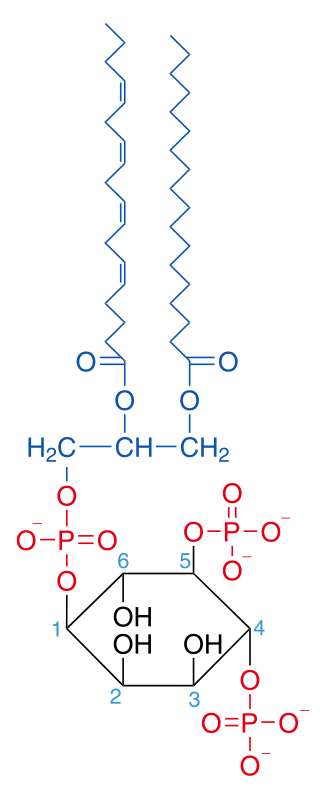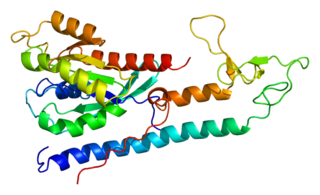Unc-13 homolog A (C. elegans) is a protein that in humans is encoded by the UNC13A gene. [5]
Unc-13 homolog A (C. elegans) is a protein that in humans is encoded by the UNC13A gene. [5]
This gene encodes a member of the UNC13 family. [5] UNC13A plays a role in vesicle maturation during exocytosis as a target of the diacylglycerol second messenger pathway. It is involved in neurotransmitter release by acting in synaptic vesicle priming prior to vesicle fusion and participates in the activity-dependent refilling of readily releasable vesicle pool. In Drosophila melanogaster , the protein has been shown to define the vesicle release site by regulating the coupling distance between synaptic vesicles and calcium channels in cooperation with another isoform, UNC13B. [6] It is particularly important in most glutamatergic-mediated synapses as well as GABA-mediated synapses. It plays a role in dendrite formation by melanocytes and in secretory granule priming in insulin secretion. [7]
Several conserved domains have been found in UNC13A. These conserved domains include three C2 domains. One C2 domain is centrally located, another is at the carboxyl end, and there is a third. In addition, there is one C1 domain, as well as Munc13 homology domains 1 (MHD1) and 2 (MHD2). [7] [8]
UNC13A is localized to the active zone of presynaptic density. It is translocated to the plasma membrane in response to phorbol ester binding. [7]
UNC13A has been shown to interact with:
Single nucleotide polymorphisms in this gene may be associated with sporadic amyotrophic lateral sclerosis. [9] [10] [11] [12] This single nucleotide polymorphism has been discovered on chromosome 19. This variation of the single nucleotide involving UNC13A has also been implicated in frontotemporal dementia (FTD). Pathology of TDP-43 in both ALS and FTD results in a cryptic exon being expressed in UNC13A, which is exercerbated by the single nucleotide polymorphisms associated with ALS and FTD risk. [13] [14] [15] This gene has also been associated with Alzheimer's disease (AD). [16]

Frontotemporal lobar degeneration (FTLD) is a pathological process that occurs in frontotemporal dementia. It is characterized by atrophy in the frontal lobe and temporal lobe of the brain, with sparing of the parietal and occipital lobes.

Phosphatidylinositol 4,5-bisphosphate or PtdIns(4,5)P2, also known simply as PIP2 or PI(4,5)P2, is a minor phospholipid component of cell membranes. PtdIns(4,5)P2 is enriched at the plasma membrane where it is a substrate for a number of important signaling proteins. PIP2 also forms lipid clusters that sort proteins.

Profilin-1 is a protein that in humans is encoded by the PFN1 gene.

Ras-related protein Rab-3A is a protein that in humans is encoded by the RAB3A gene. It is involved in calcium-triggered exocytosis in neurons.

Alsin is a protein that in humans is encoded by the ALS2 gene. ALS2 orthologs have been identified in all mammals for which complete genome data are available.

Glutamate receptor, ionotropic, kainate 1, also known as GRIK1, is a protein that in humans is encoded by the GRIK1 gene.

TAR DNA-binding protein 43 is a protein that in humans is encoded by the TARDBP gene.

Vesicle-associated membrane protein-associated protein B/C is a protein that in humans is encoded by the VAPB gene. The VAPB gene is found on the 20th human chromosome. Together with VAPA, it forms the VAP protein family.

Regulating synaptic membrane exocytosis protein 1 is a protein that in humans is encoded by the RIMS1 gene.

SNARE-associated protein Snapin is a protein that in humans is encoded by the SNAPIN gene.

Protein unc-13 homolog B is a protein that in humans is encoded by the UNC13B gene.

ATP synthase subunit delta, mitochondrial, also known as ATP synthase F1 subunit delta or F-ATPase delta subunit is an enzyme that in humans is encoded by the ATP5F1D gene. This gene encodes a subunit of mitochondrial ATP synthase. Mitochondrial ATP synthase catalyzes ATP synthesis, utilizing an electrochemical gradient of protons across the inner membrane during oxidative phosphorylation.

Transmembrane protein 106B is a protein that is encoded by the TMEM106B gene. It is found primarily within neurons and oligodendrocytes in the central nervous system with its subcellular location being in lysosomal membranes. TMEM106B helps facilitate important functions for maintaining a healthy lysosome, and therefore certain mutations and polymorphisms can lead to issues with proper lysosomal function. Lysosomes are in charge of clearing out mis-folded proteins and other debris, and thus, play an important role in neurodegenerative diseases that are driven by the accumulation of various mis-folded proteins and aggregates. Due to its impact on lysosomal function, TMEM106B has been investigated and found to be associated to multiple neurodegenerative diseases.

Vesicular glutamate transporter 1 (VGLUT1) is a protein that in humans is encoded by the SLC17A7 gene.

Syntaxin-binding protein 5 is a protein that in humans is encoded by the STXBP5 gene. It is also known as tomosyn, after 友, "friend" in Japanese, for its role as a binding protein.

Double C2-like domain-containing protein beta is a protein that in humans is encoded by the DOC2B gene.

Amyotrophic lateral sclerosis (ALS), also known as motor neurone disease (MND) or Lou Gehrig's disease, is a rare and terminal neurodegenerative disease that results in the progressive loss of motor neurons that control voluntary muscles. ALS is the most common form of the motor neuron diseases. Early symptoms of ALS include stiff muscles, muscle twitches, gradual increasing weakness, and muscle wasting. Limb-onset ALS begins with weakness in the arms or legs, while bulbar-onset ALS begins with difficulty in speaking or swallowing. Around half of people with ALS develop at least mild difficulties with thinking and behavior, and about 15% develop frontotemporal dementia. Motor neuron loss continues until the abilities to eat, speak, move, or, lastly, breathe are lost.

Interferon kappa, also known as IFN-kappa, is a protein that in humans is encoded by the IFNK gene.

C9orf72 is a protein which in humans is encoded by the gene C9orf72.
There are more than 25 genes known to be associated with amyotrophic lateral sclerosis (ALS) as of June 2018, which collectively account for about 70% of cases of familial ALS (fALS) and 10% of cases of sporadic ALS (sALS). About 5–10% of cases of ALS are directly inherited. Overall, first-degree relatives of an individual with ALS have a 1% risk of developing ALS. ALS has an oligogenic mode of inheritance, meaning that mutations in two or more genes are required to cause disease.
This article incorporates text from the United States National Library of Medicine, which is in the public domain.